In response to Warwick in another thread I have started a new one here.
Warwick Wrote:
-------------------------------------------------------
> I see the trend TOWRDS the Pyramid complex, which
> is an indicator of the Evolution of the Role of
> the Divine King in their culture as beginning
> during the reign of Khasekhem...when he changed
> his named to Khasekhemwy(my email addy), at the
> same time readopting the Horus falcon atop the
> Serekh ,dedicating a head post within the cult of
> the Sun, and of course his monstrous enclosure
> (FORT) surrounded by boat pits.
[For the readers, Khasekhemwy is the last pharaoh of the 2nd Dynasty]
You well know our understanding of the 2nd Dynasty is a mess. Peribsen, the possibly 6th or 7th pharaoh of the 2nd Dynasty of whom we have no idea how long he reigned, was the only pharaoh to adopt and replace Horus with Set in his serekh which has obvious implications as to the political state at the time between Upper and Lower Egypt. Sekhem Ib-perenmaat - who may have preceded, succeeded, or more likely been one and the same as Peribsen- used both his Horus name and double name in his serekh which some suggest is further evidence of an upheaval between the two lands in which his alleged successor, Khasekhemwy, further records battles with enemies from the north.
So bad is our understanding of the 2nd Dynasty Peribisen's name was also found on a stone vessel in the 1st Dynasty tomb of of Merneith at Abydos, interestingly a woman who may have been co-regent at the time. Emery (Archaic Egypt p94-96) notes of Peribsen that the only monument attributed to him, his tomb at the same cemetery at Abydos as Merneith, "curiously enough [his tomb] is one of the group of kings of the previous Dynasty". Emery also says that "like Akhenaten of the Eighteenth Dynasty" Peribsen erased his original Horus name of Sekhemib and replaced it with his "newly acquired" Set name of Peribsen on a funerary stela that had already been erected at the tomb (which will become more interesting later).
To quote Wilkinson regarding the 2nd Dynasty:
Khasekhemwy, the accepted last pharaoh of the 2nd Dynasty appears to have once again united the two lands which apparently culminated in the reassertion of monumental architecture surpassing anything known to have come before. As to why he changed his name (which some believe he is a different pharaoh from Khasekhem entirely), which occurred when he added Seth to his serekh along with Horus, is unknown though it is obviously superficially suggestive of a reunification of the two lands.
Few examples are found of his name Khasekhem, but under his more frequent presumed later name, Khasekhemwy, there definitely appears to have been a "new level" of foreign relations which his name is found as far afield as Byblos who we know the AE had relations with going to back into predynastic times. After the name change he is at some point referred to as the "overseer or foreign lands" supposedly corroborated by a stone block associated with him found at Hierakonpolis containing a list of foreign countries.
As impressive as Shunet ez-Zebib (name of structure below) at Abydos attributed to Khasekhemwy is, believed to be his "mortuary complex" (438ft long and 255ft wide with walls 16ft thich and over 35ft high):
![]()
![]()
He is also credited with building the massive "Fort" structure at Hierakonpolis also thought to be a "mortuary complex":
![]()
Source
Shunet ez-Zebib is located near the Dynasty 0/1st Dynasty cemetery of Umm al-Qa’ab which is divided into two cemeteries: U, which is Dynasty 0 containing among others the famous tomb U-J, and B which is 1st Dynasty beginning with the first, maybe second, 1st Dynasty king Aha. What is interesting is that at the 1st Dynasty cemetery B, other than Peribsen who I noted his name is also found in the 1st Dynasty tomb of Merneith, he and Khasekhemwy are the only 2nd Dynasty pharaohs buried at Abydos yet they both supposedly ruled at the end of the 2nd Dynasty in which Peribsen's tomb according to Emery is actually part of the group belonging to the previous Dynasty. It should be noted that Emery is definitely of the mind "Khasekhem" and "Khasekhemwy" are two different pharaohs of which there is no record of the former at Abydos, only at Hierakonpolis.
Interestingly, Shunet ez-Zebib is not Khasekhemwy's tomb at the Umm al-Qa’ab cemetery, this is:
![]()
![]()
In fact, it's not even close to Shunet ez-Zebib which is located about a mile away. This is the map of the Shunet ez-Zebib area which, again, is not the cemetry:
![]()
![]()
![]()
Recently several other such enclosures have been found which are highlighted above in yellow. Again, except those attributed to Peribsen and Khasekhemwy, they are otherwise all 1st Dynasty. It is also here that the Abydos boat graves are found which number at least 14:
![]()
Regarding these enclosures:
So, they built these enclosures at a completely different location than the cemetery then apparently after the previous pharaoh died they deliberately destroyed it and built a new one for the next guy. This practice supposedly ended with the last of the 1st Dynasty pharaohs buried there then two chuckleheads at the end of the 2nd Dynasty, some 150-200yrs later, just snuggled right in where they left off and did the same exact thing? And at the nearby cemetery, Peribsen no less was able to get a spot that was actually part of the 1st Dynasty grouping? The same Peribsen whose name is in another 1st Dynasty tomb and scratched out Sekhemib's name on a preexisting stela replacing it with his "new name"?
No, something does not smell right here. Adding exponentially to this stink is that, though there are other monuments attributed to Khasekhemwy including some that feature cut and rough dressed stone work, supposedly directly following Khasekhemwy comes Djoser in which one day we have this:
![]()
![]()
And the next all of a sudden we have this:
![]()
![]()
![]()
![]()
Ect, ect.
There is no known change of tools or materials from Khasekhemwy to Djoser nor is there any precedent for such large scale monumental stonework leading up to Djoser. I would also note that much of the Saqqara complex built by Djoser is essentially "fake" with row after row of the buildings seen there are "dummy" buildings with little or no interior comprised of facades of fine cut stone and backfill of rough cut blocks. Why do this? I would suggest the reason for this is because it is an homage to a complex found elsewhere that was recreated at Saqqara by the builders. A replica.
Also here we find the inexplicable use of fluted columns which despite whatever inspiration can be magically heaped upon Imhotep is contradicted by the fact such skill could only have come from a long tradition of column building in stone. Little known as well is the stepped pyramid of Djoser contains at least 120 tons of granite as well as one of the mastabas which contains "a dozen massive granite blocks" (Romer).
And of course now all of a sudden as well they are converting mastabs into these:
![]()
What the arrival of Djoser also emphatically shows us is a clear and absolute reversal of the location of the centralization of power from what supposedly came before him which preferred Abydos (south) returning once again to the elite royal necropolis of the 1st Dynasty at Saqqara. WTF? I thought Thanos just said the 1st Dynasty necropolis was at Abydos. Yeah, well there's another rub for you is that nearly all of those 1st Dynasty pharaohs at Abydos (south/Set) also have tombs, and much much nicer ones at that, at Saqqara (north/Horus). There are also 3 large underground complexes there believed to date to the 2nd Dynasty as well which the largest is thought to belong to the 1st pharaoh of the 2nd Dynasty, Hetepsekhemwy, that kinda reminds one of "Khasekhemwy", which the 5th Dynasty king Unas built his pyramid right over the top of it:
![]()
But the tombs of the 1st Dynasty are a topic of another time.
So, in conclusion, what I see is not a "trend" but an insurmountable gap between the 1st and 3rd Dynasties of which the morass that is the 2nd Dynasty offers no answers if only questions. Khasekhemwy is noted on multiple occasions as having been actively engaged/battling with "foreign lands" to the north which some have suggested was Lybia, even holding the title of "overseer of foreign lands", not to mention Sekhemib/Peribsen who was called "conqueror of foreign lands". I have rambled on many times about my beliefs regarding a Mesopotamian influence being responsible for the formation and administration of the early Dynastic state which seems to have collapsed in the beginning 2nd Dynasty if not signaled the end of the 1st and to some degree a unified Egypt. And while at the end of the dark age that followed there seems to be a time where these excursions into "foreign lands" brought this influence back once again which is what I would suggest is the answer to the riddle of how Saqqara and the beginning of the 3rd Dynasty came to be.
> In a many ways it has it's roots in the eastern
> dessert millennia before.
>
> WE can debate the finer points forever, and will
> do so I'm sure. But the clear observable
> development of their Royal Funerary Arrangements
> is undeniable to all but the blind.
I do not see it as a gradual linear path as you do, but rather one marked by punctuated equilibriums of foreign influence which as we can see was common throughout Egyptian history.
Warwick Wrote:
-------------------------------------------------------
> I see the trend TOWRDS the Pyramid complex, which
> is an indicator of the Evolution of the Role of
> the Divine King in their culture as beginning
> during the reign of Khasekhem...when he changed
> his named to Khasekhemwy(my email addy), at the
> same time readopting the Horus falcon atop the
> Serekh ,dedicating a head post within the cult of
> the Sun, and of course his monstrous enclosure
> (FORT) surrounded by boat pits.
[For the readers, Khasekhemwy is the last pharaoh of the 2nd Dynasty]
You well know our understanding of the 2nd Dynasty is a mess. Peribsen, the possibly 6th or 7th pharaoh of the 2nd Dynasty of whom we have no idea how long he reigned, was the only pharaoh to adopt and replace Horus with Set in his serekh which has obvious implications as to the political state at the time between Upper and Lower Egypt. Sekhem Ib-perenmaat - who may have preceded, succeeded, or more likely been one and the same as Peribsen- used both his Horus name and double name in his serekh which some suggest is further evidence of an upheaval between the two lands in which his alleged successor, Khasekhemwy, further records battles with enemies from the north.
So bad is our understanding of the 2nd Dynasty Peribisen's name was also found on a stone vessel in the 1st Dynasty tomb of of Merneith at Abydos, interestingly a woman who may have been co-regent at the time. Emery (Archaic Egypt p94-96) notes of Peribsen that the only monument attributed to him, his tomb at the same cemetery at Abydos as Merneith, "curiously enough [his tomb] is one of the group of kings of the previous Dynasty". Emery also says that "like Akhenaten of the Eighteenth Dynasty" Peribsen erased his original Horus name of Sekhemib and replaced it with his "newly acquired" Set name of Peribsen on a funerary stela that had already been erected at the tomb (which will become more interesting later).
To quote Wilkinson regarding the 2nd Dynasty:
Quote
The kings who ruled Egypt between the death of Qaa and the accession of Netjerikhet/Djoser are some of the most shadowy figures from the entire span of Egyptian history (cf. Dodson 1996). The inscriptions and monuments from the period record a plethora of royal names, as do the surviving king lists. The names of these two sets of sources bear little relation to each other. It has proved difficult, if not impossible, to reconcile the varying lists and sequences, and scholars today are scarcely more confident about the internal history of the Second Dynasty than were their predecessors a generation ago.
Khasekhemwy, the accepted last pharaoh of the 2nd Dynasty appears to have once again united the two lands which apparently culminated in the reassertion of monumental architecture surpassing anything known to have come before. As to why he changed his name (which some believe he is a different pharaoh from Khasekhem entirely), which occurred when he added Seth to his serekh along with Horus, is unknown though it is obviously superficially suggestive of a reunification of the two lands.
Few examples are found of his name Khasekhem, but under his more frequent presumed later name, Khasekhemwy, there definitely appears to have been a "new level" of foreign relations which his name is found as far afield as Byblos who we know the AE had relations with going to back into predynastic times. After the name change he is at some point referred to as the "overseer or foreign lands" supposedly corroborated by a stone block associated with him found at Hierakonpolis containing a list of foreign countries.
As impressive as Shunet ez-Zebib (name of structure below) at Abydos attributed to Khasekhemwy is, believed to be his "mortuary complex" (438ft long and 255ft wide with walls 16ft thich and over 35ft high):

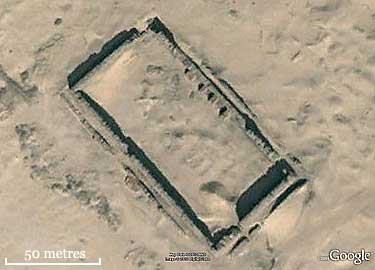
He is also credited with building the massive "Fort" structure at Hierakonpolis also thought to be a "mortuary complex":
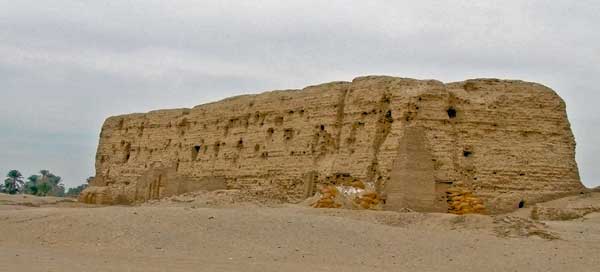
Source
Shunet ez-Zebib is located near the Dynasty 0/1st Dynasty cemetery of Umm al-Qa’ab which is divided into two cemeteries: U, which is Dynasty 0 containing among others the famous tomb U-J, and B which is 1st Dynasty beginning with the first, maybe second, 1st Dynasty king Aha. What is interesting is that at the 1st Dynasty cemetery B, other than Peribsen who I noted his name is also found in the 1st Dynasty tomb of Merneith, he and Khasekhemwy are the only 2nd Dynasty pharaohs buried at Abydos yet they both supposedly ruled at the end of the 2nd Dynasty in which Peribsen's tomb according to Emery is actually part of the group belonging to the previous Dynasty. It should be noted that Emery is definitely of the mind "Khasekhem" and "Khasekhemwy" are two different pharaohs of which there is no record of the former at Abydos, only at Hierakonpolis.
Interestingly, Shunet ez-Zebib is not Khasekhemwy's tomb at the Umm al-Qa’ab cemetery, this is:
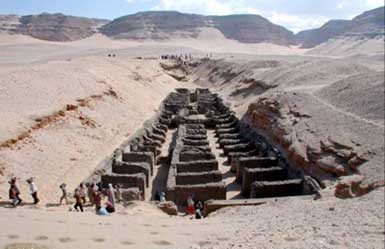
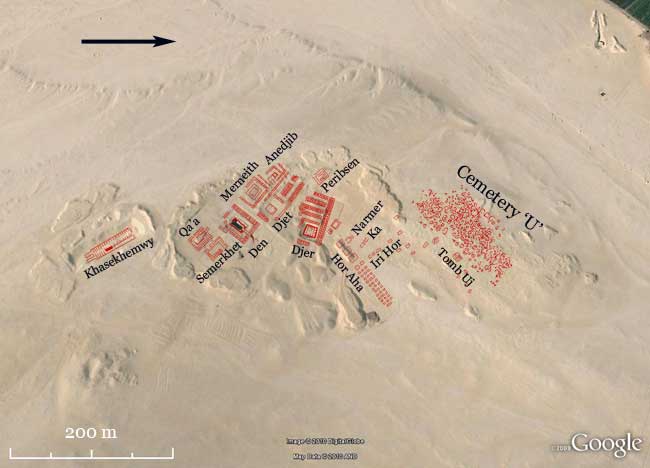
In fact, it's not even close to Shunet ez-Zebib which is located about a mile away. This is the map of the Shunet ez-Zebib area which, again, is not the cemetry:
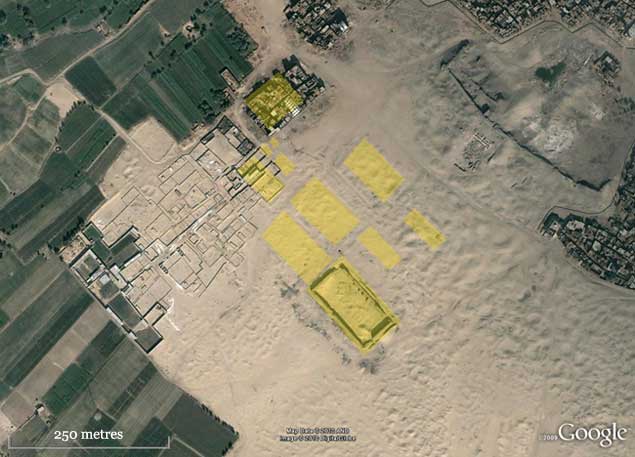
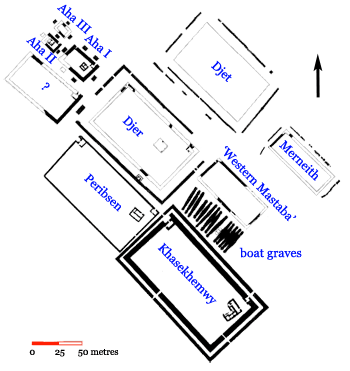
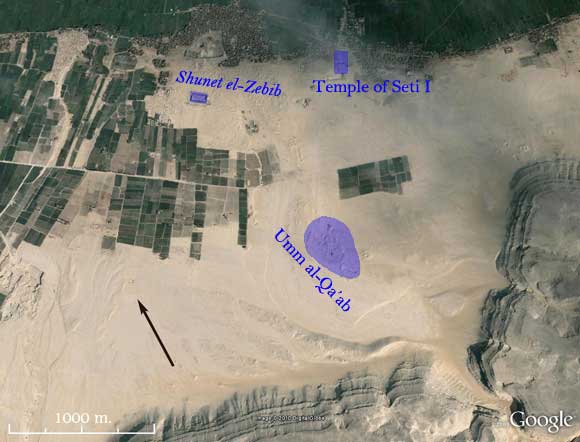
Recently several other such enclosures have been found which are highlighted above in yellow. Again, except those attributed to Peribsen and Khasekhemwy, they are otherwise all 1st Dynasty. It is also here that the Abydos boat graves are found which number at least 14:

Regarding these enclosures:
SourceQuote
Each royal monument consisted of a ritual precinct open to the sky enclosed by massive mudbrick walls. The Institute’s excavations have resulted in the discovery of the earliest royal enclosures yet known, dating to the reign of king Aha at the beginning of the 1st Dynasty (ca. 3050 BCE). The Institute’s work has also revealed important aspects of how these structures were used as the setting for ritual. Most surprisingly, it appears that these important royal monuments appear to have been deliberately, even ritually demolished and symbolically buried after only a short period of use, probably limited to the reign of the king for whom each was built.
The known enclosures of the 1st Dynasty (ca. 3050-2900 BCE) were regularly accompanied by important ancillary features. Most were surrounded by lines of tombs, and the Institute’s work has produced important new evidence that courtiers and retainers were sacrificed and entombed around the royal enclosure, probably so that they could accompany the king into the next world. In one instance a royal enclosure was accompanied by the burials of ten donkeys in three brick tomb chambers, the earliest complete donkey skeletons ever discovered in the world. In another, one of the enclosures had associated graves that contained, not humans or animals, but, spectacularly, the wooden hulls of a fleet of fourteen large boats, the oldest built boats known. The boats and donkeys, like the sacrificed courtiers, were probably buried to be symbolically translated from this world to the next, to be available to the king there.
So, they built these enclosures at a completely different location than the cemetery then apparently after the previous pharaoh died they deliberately destroyed it and built a new one for the next guy. This practice supposedly ended with the last of the 1st Dynasty pharaohs buried there then two chuckleheads at the end of the 2nd Dynasty, some 150-200yrs later, just snuggled right in where they left off and did the same exact thing? And at the nearby cemetery, Peribsen no less was able to get a spot that was actually part of the 1st Dynasty grouping? The same Peribsen whose name is in another 1st Dynasty tomb and scratched out Sekhemib's name on a preexisting stela replacing it with his "new name"?
No, something does not smell right here. Adding exponentially to this stink is that, though there are other monuments attributed to Khasekhemwy including some that feature cut and rough dressed stone work, supposedly directly following Khasekhemwy comes Djoser in which one day we have this:


And the next all of a sudden we have this:
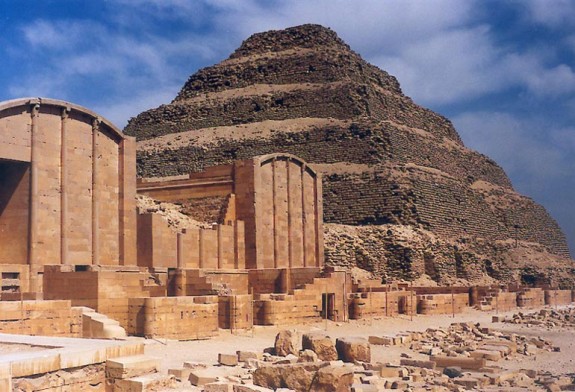



Ect, ect.
There is no known change of tools or materials from Khasekhemwy to Djoser nor is there any precedent for such large scale monumental stonework leading up to Djoser. I would also note that much of the Saqqara complex built by Djoser is essentially "fake" with row after row of the buildings seen there are "dummy" buildings with little or no interior comprised of facades of fine cut stone and backfill of rough cut blocks. Why do this? I would suggest the reason for this is because it is an homage to a complex found elsewhere that was recreated at Saqqara by the builders. A replica.
Also here we find the inexplicable use of fluted columns which despite whatever inspiration can be magically heaped upon Imhotep is contradicted by the fact such skill could only have come from a long tradition of column building in stone. Little known as well is the stepped pyramid of Djoser contains at least 120 tons of granite as well as one of the mastabas which contains "a dozen massive granite blocks" (Romer).
And of course now all of a sudden as well they are converting mastabs into these:

What the arrival of Djoser also emphatically shows us is a clear and absolute reversal of the location of the centralization of power from what supposedly came before him which preferred Abydos (south) returning once again to the elite royal necropolis of the 1st Dynasty at Saqqara. WTF? I thought Thanos just said the 1st Dynasty necropolis was at Abydos. Yeah, well there's another rub for you is that nearly all of those 1st Dynasty pharaohs at Abydos (south/Set) also have tombs, and much much nicer ones at that, at Saqqara (north/Horus). There are also 3 large underground complexes there believed to date to the 2nd Dynasty as well which the largest is thought to belong to the 1st pharaoh of the 2nd Dynasty, Hetepsekhemwy, that kinda reminds one of "Khasekhemwy", which the 5th Dynasty king Unas built his pyramid right over the top of it:

But the tombs of the 1st Dynasty are a topic of another time.
So, in conclusion, what I see is not a "trend" but an insurmountable gap between the 1st and 3rd Dynasties of which the morass that is the 2nd Dynasty offers no answers if only questions. Khasekhemwy is noted on multiple occasions as having been actively engaged/battling with "foreign lands" to the north which some have suggested was Lybia, even holding the title of "overseer of foreign lands", not to mention Sekhemib/Peribsen who was called "conqueror of foreign lands". I have rambled on many times about my beliefs regarding a Mesopotamian influence being responsible for the formation and administration of the early Dynastic state which seems to have collapsed in the beginning 2nd Dynasty if not signaled the end of the 1st and to some degree a unified Egypt. And while at the end of the dark age that followed there seems to be a time where these excursions into "foreign lands" brought this influence back once again which is what I would suggest is the answer to the riddle of how Saqqara and the beginning of the 3rd Dynasty came to be.
> In a many ways it has it's roots in the eastern
> dessert millennia before.
>
> WE can debate the finer points forever, and will
> do so I'm sure. But the clear observable
> development of their Royal Funerary Arrangements
> is undeniable to all but the blind.
I do not see it as a gradual linear path as you do, but rather one marked by punctuated equilibriums of foreign influence which as we can see was common throughout Egyptian history.